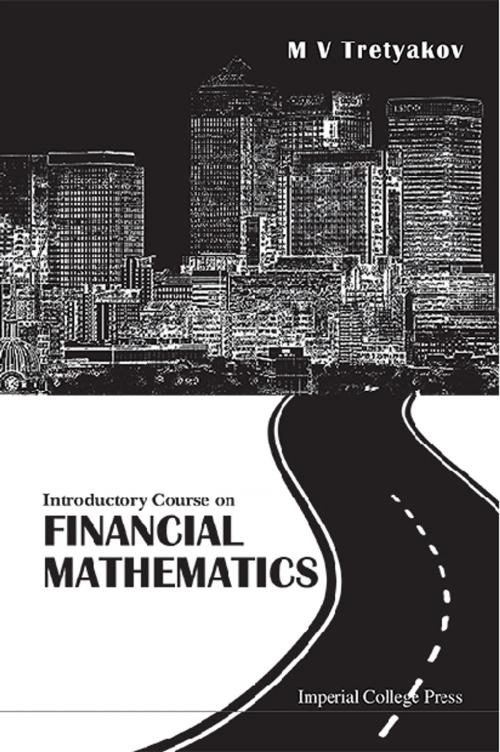Introductory Course on Financial Mathematics
Nonfiction, Science & Nature, Mathematics, Applied, Business & Finance, Finance & Investing, Finance| Author: | M V Tretyakov | ISBN: | 9781908977403 |
| Publisher: | World Scientific Publishing Company | Publication: | July 23, 2013 |
| Imprint: | ICP | Language: | English |
| Author: | M V Tretyakov |
| ISBN: | 9781908977403 |
| Publisher: | World Scientific Publishing Company |
| Publication: | July 23, 2013 |
| Imprint: | ICP |
| Language: | English |
This book is an elementary introduction to the basic concepts of financial mathematics with a central focus on discrete models and an aim to demonstrate simple, but widely used, financial derivatives for managing market risks. Only a basic knowledge of probability, real analysis, ordinary differential equations, linear algebra and some common sense are required to understand the concepts considered in this book.
Financial mathematics is an application of advanced mathematical and statistical methods to financial management and markets, with a main objective of quantifying and hedging risks. Since the book aims to present the basics of financial mathematics to the reader, only essential elements of probability and stochastic analysis are given to explain ideas concerning derivative pricing and hedging. To keep the reader intrigued and motivated, the book has a ‘sandwich’ structure: probability and stochastics are given in situ where mathematics can be readily illustrated by application to finance.
The first part of the book introduces one of the main principles in finance — ‘no arbitrage pricing’. It also introduces main financial instruments such as forward and futures contracts, bonds and swaps, and options. The second part deals with pricing and hedging of European- and American-type options in the discrete-time setting. In addition, the concept of complete and incomplete markets is discussed. Elementary probability is briefly revised and discrete-time discrete-space stochastic processes used in financial modelling are considered. The third part introduces the Wiener process, Ito integrals and stochastic differential equations, but its main focus is the famous Black–Scholes formula for pricing European options. Some guidance for further study within this exciting and rapidly changing field is given in the concluding chapter. There are approximately 100 exercises interspersed throughout the book, and solutions for most problems are provided in the appendices.
Contents:
-
Historical Remarks
-
Financial Instruments and Arbitrage:
- Preliminary Examples
- Forwards, Futures and Arbitrage
- Bonds and Swaps
- European Options
- Problems for Part I
-
Discrete-Time Stochastic Modelling and Option Pricing:
- Binary Model of Price Evolution
- Elements of Probability Theory
- Discrete-Time Stochastic Processes
- Multiperiod Binary Tree Model
- Complete and Incomplete Markets
- American Options
- Problems for Part II
-
Continuous-Time Stochastic Modelling and the Black—Scholes Formula:
- Connection to 'Reality'
- Probabilistic Model for an Experiment with Infinitely Many Outcomes
- Limit of the Discrete-Price Model and Price of a European Option in the Continuous-Time Case
- Brownian Motion (Wiener Process)
- Simplistic Introduction to Ito Calculus
- Problems for Part III
- Further Study
- Appendix: Solutions
Readership: Undergraduate and postgraduate students taking a course in financial mathematics.
Key Features:
- This book has its own niche: a textbook for an elementary, short course on financial mathematics
- This book is based on a one-semester course for undergraduate and postgraduate students, which has been taught since 2004. It is also the basis for an MSc course in actuarial science, which covers about one half of the CT8 “Financial Economics” syllabus and some parts of CT1 “Financial Mathematics” syllabus of the Institute of Actuaries (UK) professional exams
- Exercises and solutions relevant to the material covered in the book are provided
This book is an elementary introduction to the basic concepts of financial mathematics with a central focus on discrete models and an aim to demonstrate simple, but widely used, financial derivatives for managing market risks. Only a basic knowledge of probability, real analysis, ordinary differential equations, linear algebra and some common sense are required to understand the concepts considered in this book.
Financial mathematics is an application of advanced mathematical and statistical methods to financial management and markets, with a main objective of quantifying and hedging risks. Since the book aims to present the basics of financial mathematics to the reader, only essential elements of probability and stochastic analysis are given to explain ideas concerning derivative pricing and hedging. To keep the reader intrigued and motivated, the book has a ‘sandwich’ structure: probability and stochastics are given in situ where mathematics can be readily illustrated by application to finance.
The first part of the book introduces one of the main principles in finance — ‘no arbitrage pricing’. It also introduces main financial instruments such as forward and futures contracts, bonds and swaps, and options. The second part deals with pricing and hedging of European- and American-type options in the discrete-time setting. In addition, the concept of complete and incomplete markets is discussed. Elementary probability is briefly revised and discrete-time discrete-space stochastic processes used in financial modelling are considered. The third part introduces the Wiener process, Ito integrals and stochastic differential equations, but its main focus is the famous Black–Scholes formula for pricing European options. Some guidance for further study within this exciting and rapidly changing field is given in the concluding chapter. There are approximately 100 exercises interspersed throughout the book, and solutions for most problems are provided in the appendices.
Contents:
-
Historical Remarks
-
Financial Instruments and Arbitrage:
- Preliminary Examples
- Forwards, Futures and Arbitrage
- Bonds and Swaps
- European Options
- Problems for Part I
-
Discrete-Time Stochastic Modelling and Option Pricing:
- Binary Model of Price Evolution
- Elements of Probability Theory
- Discrete-Time Stochastic Processes
- Multiperiod Binary Tree Model
- Complete and Incomplete Markets
- American Options
- Problems for Part II
-
Continuous-Time Stochastic Modelling and the Black—Scholes Formula:
- Connection to 'Reality'
- Probabilistic Model for an Experiment with Infinitely Many Outcomes
- Limit of the Discrete-Price Model and Price of a European Option in the Continuous-Time Case
- Brownian Motion (Wiener Process)
- Simplistic Introduction to Ito Calculus
- Problems for Part III
- Further Study
- Appendix: Solutions
Readership: Undergraduate and postgraduate students taking a course in financial mathematics.
Key Features:
- This book has its own niche: a textbook for an elementary, short course on financial mathematics
- This book is based on a one-semester course for undergraduate and postgraduate students, which has been taught since 2004. It is also the basis for an MSc course in actuarial science, which covers about one half of the CT8 “Financial Economics” syllabus and some parts of CT1 “Financial Mathematics” syllabus of the Institute of Actuaries (UK) professional exams
- Exercises and solutions relevant to the material covered in the book are provided















